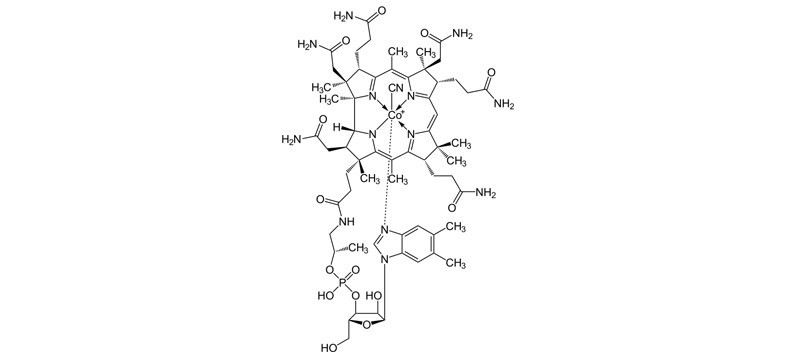What is Cyanocobalamin?
Cyanocobalamin is one of the most widely available forms of vitamin B12 in supplements and has been successfully used in vitamin B12 treatment for many years. Through injections as well as oral supplements, cyanocobalamin has cured many forms of vitamin B12 deficiency and has also proven to be very effective when treating anaemia patients.
The broad application of cyanocobalamin can be attributed above all to its advantages in the production process: no form of vitamin B12 is as easy or cheap to produce. Plus, its chemical stability gives it a particularly long shelf life.
Cyanocobalamin and the Discovery of Vitamin B12
Cyanocobalamin is closely intertwined with the history of vitamin B12, which was given its name in 1948 when the vitamin was first successfully isolated. In 1956, the form that had been discovered turned out to be cyanocobalamin. For a long time thereafter it was believed that cyanocobalamin was identical to vitamin B12 and that this coordination compound must therefore be the naturally occurring form of the vitamin. It took many more years of research before it was realised that cyanocobalamin was formed as a result of contamination in the activated carbon used in the isolation process. In addition, it was discovered that cyanocobalamin does not naturally occur in any notable quantities in the body nor in foods, and actually causes absolutely no effect of its own (1).
As a result, an inadvertent and practical method had been found to stabilise this very delicate vitamin, accompanied by the discovery that hydroxocobalamin is actually the naturally occurring form of vitamin B12 (as produced by microorganisms) and that the active forms found in the body are in fact methylcobalamin and adenosylcobalamin.
Cyanocobalamin B12 – Synthetic B12
Cyanocobalamin is therefore an artificial form of vitamin B12, which does not naturally occur unless as a pollutant or decontaminant. As a result, the body cannot utilise it directly, since it must first be broken down into the two bioactive coenzymes: methylcobalamin and adenosylcobalamin. There are four metabolic steps required for this process, with one part of the cyanocobalamin converted after the first step into hydroxocobalamin, which occurs in the body as a preform of the coenzymes.
Clearly, the necessary conversion constitutes a metabolic disadvantage, yet under normal circumstances functions without difficulty. As part of the consumed cyanocobalamin is however excreted before it can be converted, the bioavailability of this form is comparatively not particularly ideal.
Is Cyanocobalamin Toxic?
Cyanocobalamin is, as its name suggests, a bond between vitamin B12 and a cyano group. These are split in the body and the reaction partly produces cyanide, a substance commonly known as a neurotoxin. This often leads to fears that cyanocobalamin is toxic or dangerous. However, this is not entirely accurate, since the amount of cyanide produced is so low that only the very sensitive or those with high levels of existing cyanide exposure (e.g. smokers) are genuinely at risk. Nevertheless, the question remains as to why such a form should be chosen when there are more beneficial alternatives available (2).
The most important factor to consider is the specific effects and advantages of the three naturally active forms of B12 against many diseases and health problems. It is thus advisable to select supplements taken contain a mixture of these natural forms of vitamin B12 if possible, rather than simply synthetic cyanocobalamin.
Cyanocobalamin: Good Price, Mediocre Effect
In terms of effect too, cyanocobalamin is far from optimal. When directly compared to other active ingredients, cyanocobalamin is significantly cheaper yet cannot compete with the natural B12 forms when it comes to effect (3). For example, the average resorption rate for cyanocobalamin injections is 20-50%, while for hydroxocobalamin it is as much as 70% (4). Cyanocobalamin is also inferior to methylcobalamin here (5) and, what is more, the latter is a bioactive form and can be directly processed by the body.
In spite of this, cyanocobalamin remains very effective for healthy people looking to cover their daily requirement and avoid vitamin B12 deficiency, as years of practice have shown. For treatment purposes however, many vitamin experts recommend working with the natural coenzyme forms, which have proven themselves to be superior in many contexts. In regards to various diseases, the natural forms can be used to achieve successes that cannot be achieved with cyanocobalamin.
Those who want to profit from the health benefits of the natural forms should consider whether to also use these vitamin B12 forms for standard day-to-day use. Food supplements are currently available that contain hydroxocobalamin and methylcobalamin, both of which can also be excellently combined.
Sources
- Victor Herbert (1988). “Vitamin B-12: plant sources, requirements, and assay”. American Journal of Clinical Nutrition 48 (3 Suppl): 852–8. PMID 3046314
- J.C. Linnell,D.M. Matthews,J.M. England Therapeutic Misuse of Cyanocobalamin. The Lancet – 11 November 1978 ( Vol. 312, Issue 8098, Pages 1053-1054 ) DOI: 10.1016/S0140-6736(78)92379-6
- A.G. Freeman Cyanocobalamin – a case for withdrawal: discussion paper. J R Soc Med. Nov 1992; 85(11): 686–687.
- Hertz, H., Kristensen, H. P. Ø. and Hoff-JØrgensen, E. (1964), Studies on Vitamin B12 Retention Comparison of Retention Following Intramuscular Injection of Cyanocobalamin and Hydroxocobalamin. Scandinavian Journal of Haematology, 1: 5–15. doi: 10.1111/j.1600-0609.1964.tb00001.x
- Okuda K, Yashima K, Kitazaki T, Takara I. Intestinal absorption and concurrent chemical changes of methylcobalamin. J Lab Clin Med. 1973 Apr;81(4):557-67. PubMed PMID: 4696188.


